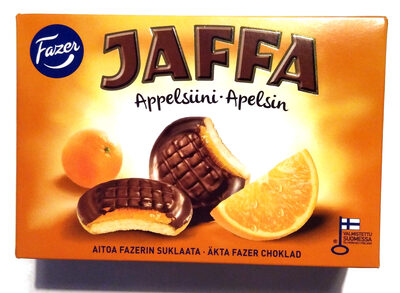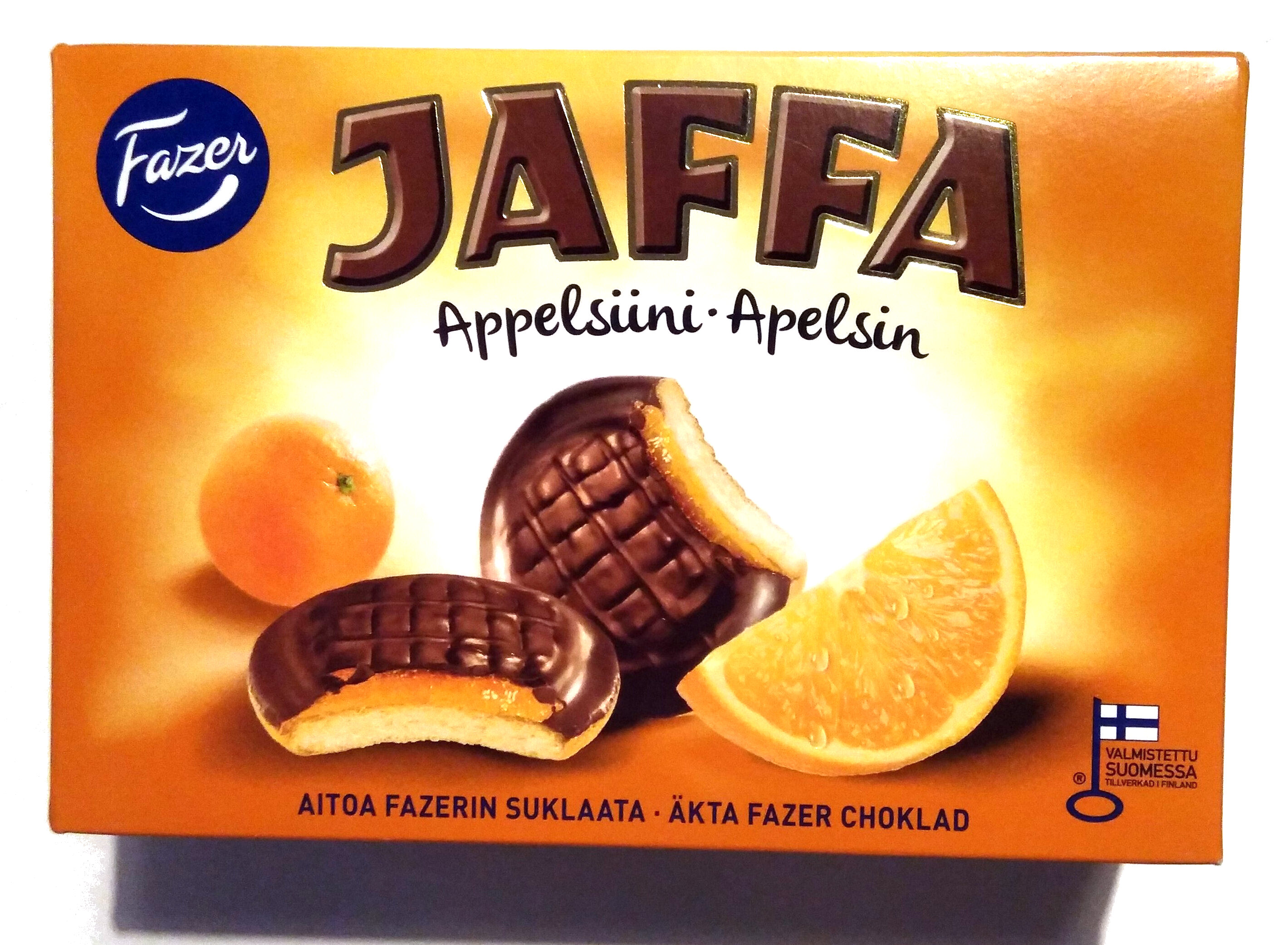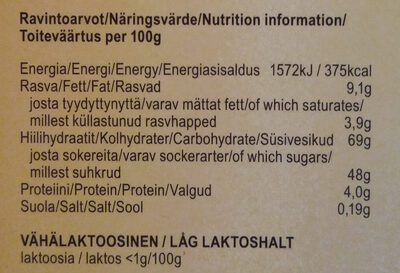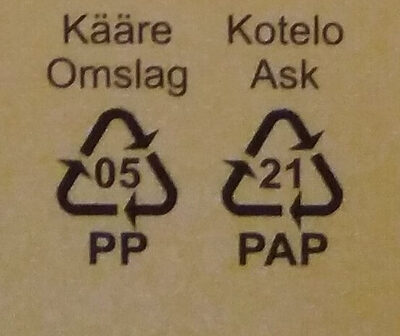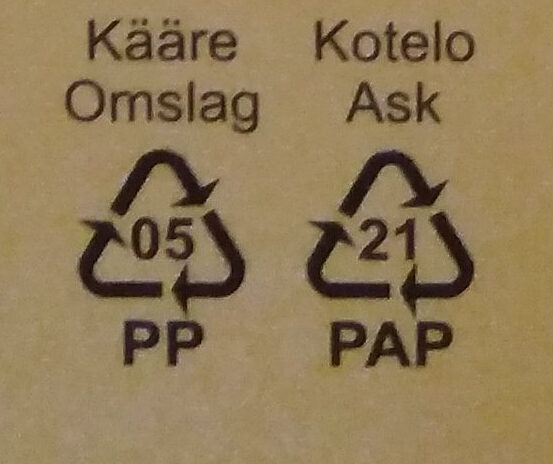Help us make food transparency the norm!
As a non-profit organization, we depend on your donations to continue informing consumers around the world about what they eat.
The food revolution starts with you!
Jaffa Apelsin - Fazer - 300 g (24)
Jaffa Apelsin - Fazer - 300 g (24)
This product page is not complete. You can help to complete it by editing it and adding more data from the photos we have, or by taking more photos using the app for Android or iPhone/iPad. Thank you!
×
Streckkod: 6416453554641 (EAN / EAN-13)
Vanligt namn: Chokladöverdragna mjuka småkakor med apelsinsmakande fyllning
Kvantitet: 300 g (24)
Förpackning: Plast, Kartong, PP 5 - polypropen, en:Box, 21 PAP, en:Container
Varumärken: Fazer
Kategorier: Snacks, Söta snacks, Kakor och tårtor, Tårta, en:Jaffa cakes, en:Soft cake filled with fruits
Etiketter, certifieringar, utmärkelser:
en:Avainlippu
Tillverknings eller bearbetningsplats: Finland
Länk till produktsidan på producentens officiella webbplats: https://www.fazer.fi/tuotteet-ja-asiakas...
Butiker: K-market
Länder där såld: Finland
Matching with your preferences
Hälsa
Ingredienser
-
32 ingredienser
Socker, glukossirap, vetemjöl, ägg, kakaomassa, dextros, stabiliseringsmedel (E422), vegetabilisk olja (ryps), kakaosmör, vegetabiliskt fett (palm, shea), mjölkfett, surhetsreglerande medel (E330, E331), apelsinjuicekoncentrat (0,6%), geleringsmedel (E440), jäsningsmedel (E503, E500, E450), aromer, emulgeringsmedel (E471, lecitin bl.a. soja, E475), färgämne (E160a). Chokladen innehåller minst 42% kakao.Allergener: Ägg, Gluten, Mjölk, Soja
Food processing
-
Ultra processed foods
Elements that indicate the product is in the 4 - Ultra bearbetade livsmedel och drycker group:
- Tillsats: E160a - Karoten
- Tillsats: E422 - Glycerol
- Tillsats: E440 - Pektiner
- Tillsats: E450 - Difosfater
- Tillsats: E471 - Mono- och diglycerider av fettsyror
- Tillsats: E475 - Polyglycerolestrar av fettsyror
- Ingrediens: Färg
- Ingrediens: Dextros
- Ingrediens: Emulgeringsmedel
- Ingrediens: Arom
- Ingrediens: Geleringsmedel
- Ingrediens: Glukos
- Ingrediens: Glukossirap
Food products are classified into 4 groups according to their degree of processing:
- Obearbetade eller minimalt bearbetade livsmedel
- Bearbetade kulinariska ingredienser
- Halvfabrikat
- Ultra processed foods
The determination of the group is based on the category of the product and on the ingredients it contains.
Tillsatser
-
E160a - Karoten
Carotene: The term carotene -also carotin, from the Latin carota, "carrot"- is used for many related unsaturated hydrocarbon substances having the formula C40Hx, which are synthesized by plants but in general cannot be made by animals -with the exception of some aphids and spider mites which acquired the synthesizing genes from fungi-. Carotenes are photosynthetic pigments important for photosynthesis. Carotenes contain no oxygen atoms. They absorb ultraviolet, violet, and blue light and scatter orange or red light, and -in low concentrations- yellow light. Carotenes are responsible for the orange colour of the carrot, for which this class of chemicals is named, and for the colours of many other fruits, vegetables and fungi -for example, sweet potatoes, chanterelle and orange cantaloupe melon-. Carotenes are also responsible for the orange -but not all of the yellow- colours in dry foliage. They also -in lower concentrations- impart the yellow coloration to milk-fat and butter. Omnivorous animal species which are relatively poor converters of coloured dietary carotenoids to colourless retinoids have yellowed-coloured body fat, as a result of the carotenoid retention from the vegetable portion of their diet. The typical yellow-coloured fat of humans and chickens is a result of fat storage of carotenes from their diets. Carotenes contribute to photosynthesis by transmitting the light energy they absorb to chlorophyll. They also protect plant tissues by helping to absorb the energy from singlet oxygen, an excited form of the oxygen molecule O2 which is formed during photosynthesis. β-Carotene is composed of two retinyl groups, and is broken down in the mucosa of the human small intestine by β-carotene 15‚15'-monooxygenase to retinal, a form of vitamin A. β-Carotene can be stored in the liver and body fat and converted to retinal as needed, thus making it a form of vitamin A for humans and some other mammals. The carotenes α-carotene and γ-carotene, due to their single retinyl group -β-ionone ring-, also have some vitamin A activity -though less than β-carotene-, as does the xanthophyll carotenoid β-cryptoxanthin. All other carotenoids, including lycopene, have no beta-ring and thus no vitamin A activity -although they may have antioxidant activity and thus biological activity in other ways-. Animal species differ greatly in their ability to convert retinyl -beta-ionone- containing carotenoids to retinals. Carnivores in general are poor converters of dietary ionone-containing carotenoids. Pure carnivores such as ferrets lack β-carotene 15‚15'-monooxygenase and cannot convert any carotenoids to retinals at all -resulting in carotenes not being a form of vitamin A for this species-; while cats can convert a trace of β-carotene to retinol, although the amount is totally insufficient for meeting their daily retinol needs.Källa: Wikipedia (Engelska)
-
E330 - Citronsyra
Citric acid: Citric acid is a weak organic acid that has the chemical formula C6H8O7. It occurs naturally in citrus fruits. In biochemistry, it is an intermediate in the citric acid cycle, which occurs in the metabolism of all aerobic organisms. More than a million tons of citric acid are manufactured every year. It is used widely as an acidifier, as a flavoring and chelating agent.A citrate is a derivative of citric acid; that is, the salts, esters, and the polyatomic anion found in solution. An example of the former, a salt is trisodium citrate; an ester is triethyl citrate. When part of a salt, the formula of the citrate ion is written as C6H5O3−7 or C3H5O-COO-3−3.Källa: Wikipedia (Engelska)
-
E331 - Natriumcitrater
Sodium citrate: Sodium citrate may refer to any of the sodium salts of citrate -though most commonly the third-: Monosodium citrate Disodium citrate Trisodium citrateThe three forms of the salt are collectively known by the E number E331. Sodium citrates are used as acidity regulators in food and drinks, and also as emulsifiers for oils. They enable cheeses to melt without becoming greasy.Källa: Wikipedia (Engelska)
-
E422 - Glycerol
Glycerol: Glycerol -; also called glycerine or glycerin; see spelling differences- is a simple polyol compound. It is a colorless, odorless, viscous liquid that is sweet-tasting and non-toxic. The glycerol backbone is found in all lipids known as triglycerides. It is widely used in the food industry as a sweetener and humectant and in pharmaceutical formulations. Glycerol has three hydroxyl groups that are responsible for its solubility in water and its hygroscopic nature.Källa: Wikipedia (Engelska)
-
E440 - Pektiner
Pectin: Pectin -from Ancient Greek: πηκτικός pēktikós, "congealed, curdled"- is a structural heteropolysaccharide contained in the primary cell walls of terrestrial plants. It was first isolated and described in 1825 by Henri Braconnot. It is produced commercially as a white to light brown powder, mainly extracted from citrus fruits, and is used in food as a gelling agent, particularly in jams and jellies. It is also used in dessert fillings, medicines, sweets, as a stabilizer in fruit juices and milk drinks, and as a source of dietary fiber.Källa: Wikipedia (Engelska)
-
E471 - Mono- och diglycerider av fettsyror
Mono- and diglycerides of fatty acids: Mono- and diglycerides of fatty acids -E471- refers to a food additive composed of diglycerides and monoglycerides which is used as an emulsifier. This mixture is also sometimes referred to as partial glycerides.Källa: Wikipedia (Engelska)
-
E500 - Natriumkarbonater
Sodium carbonate: Sodium carbonate, Na2CO3, -also known as washing soda, soda ash and soda crystals, and in the monohydrate form as crystal carbonate- is the water-soluble sodium salt of carbonic acid. It most commonly occurs as a crystalline decahydrate, which readily effloresces to form a white powder, the monohydrate. Pure sodium carbonate is a white, odorless powder that is hygroscopic -absorbs moisture from the air-. It has a strongly alkaline taste, and forms a moderately basic solution in water. Sodium carbonate is well known domestically for its everyday use as a water softener. Historically it was extracted from the ashes of plants growing in sodium-rich soils, such as vegetation from the Middle East, kelp from Scotland and seaweed from Spain. Because the ashes of these sodium-rich plants were noticeably different from ashes of timber -used to create potash-, they became known as "soda ash". It is synthetically produced in large quantities from salt -sodium chloride- and limestone by a method known as the Solvay process. The manufacture of glass is one of the most important uses of sodium carbonate. Sodium carbonate acts as a flux for silica, lowering the melting point of the mixture to something achievable without special materials. This "soda glass" is mildly water-soluble, so some calcium carbonate is added to the melt mixture to make the glass produced insoluble. This type of glass is known as soda lime glass: "soda" for the sodium carbonate and "lime" for the calcium carbonate. Soda lime glass has been the most common form of glass for centuries. Sodium carbonate is also used as a relatively strong base in various settings. For example, it is used as a pH regulator to maintain stable alkaline conditions necessary for the action of the majority of photographic film developing agents. It acts as an alkali because when dissolved in water, it dissociates into the weak acid: carbonic acid and the strong alkali: sodium hydroxide. This gives sodium carbonate in solution the ability to attack metals such as aluminium with the release of hydrogen gas.It is a common additive in swimming pools used to raise the pH which can be lowered by chlorine tablets and other additives which contain acids. In cooking, it is sometimes used in place of sodium hydroxide for lyeing, especially with German pretzels and lye rolls. These dishes are treated with a solution of an alkaline substance to change the pH of the surface of the food and improve browning. In taxidermy, sodium carbonate added to boiling water will remove flesh from the bones of animal carcasses for trophy mounting or educational display. In chemistry, it is often used as an electrolyte. Electrolytes are usually salt-based, and sodium carbonate acts as a very good conductor in the process of electrolysis. In addition, unlike chloride ions, which form chlorine gas, carbonate ions are not corrosive to the anodes. It is also used as a primary standard for acid-base titrations because it is solid and air-stable, making it easy to weigh accurately.Källa: Wikipedia (Engelska)
-
E503 - Ammoniumkarbonater
Ammonium carbonate: Ammonium carbonate is a salt with the chemical formula -NH4-2CO3. Since it readily degrades to gaseous ammonia and carbon dioxide upon heating, it is used as a leavening agent and also as smelling salt. It is also known as baker's ammonia and was a predecessor to the more modern leavening agents baking soda and baking powder. It is a component of what was formerly known as sal volatile and salt of hartshorn.Källa: Wikipedia (Engelska)
Ingrediensanalys
-
Palmolja
Ingredienser som innehåller palmolja: Palm
-
Icke-vegan
Non-vegan ingredients: en:Chicken egg, MjölkfettVissa ingredienser kunde inte kännas igen.
Vi behöver din hjälp!
You can help us recognize more ingredients and better analyze the list of ingredients for this product and others:
- Edit this product page to correct spelling mistakes in the ingredients list, and/or to remove ingredients in other languages and sentences that are not related to the ingredients.
- Add new entries, synonyms or translations to our multilingual lists of ingredients, ingredient processing methods, and labels.
If you would like to help, join the #ingredients channel on our Slack discussion space and/or learn about ingredients analysis on our wiki. Thank you!
-
Vegetarisk status okänd
Okända ingredienser: fi:lesitiini-muun-muassa-soijaVissa ingredienser kunde inte kännas igen.
Vi behöver din hjälp!
You can help us recognize more ingredients and better analyze the list of ingredients for this product and others:
- Edit this product page to correct spelling mistakes in the ingredients list, and/or to remove ingredients in other languages and sentences that are not related to the ingredients.
- Add new entries, synonyms or translations to our multilingual lists of ingredients, ingredient processing methods, and labels.
If you would like to help, join the #ingredients channel on our Slack discussion space and/or learn about ingredients analysis on our wiki. Thank you!
-
Details of the analysis of the ingredients
Vi behöver din hjälp!
Vissa ingredienser kunde inte kännas igen.
Vi behöver din hjälp!
You can help us recognize more ingredients and better analyze the list of ingredients for this product and others:
- Edit this product page to correct spelling mistakes in the ingredients list, and/or to remove ingredients in other languages and sentences that are not related to the ingredients.
- Add new entries, synonyms or translations to our multilingual lists of ingredients, ingredient processing methods, and labels.
If you would like to help, join the #ingredients channel on our Slack discussion space and/or learn about ingredients analysis on our wiki. Thank you!
: Sokeri, glukoosisiirappi, _vehnäjauho_, _kananmuna_, kaakaomassa, dekstroosi, stabilointiaine (e422), kasviöljy (rypsi), kaakaovoi, kasvirasva (palmu, shea), _maitorasva_, happamuudensäätöaineet (e330, e331), appelsiinitäysmehutiiviste 0.6%, hyytelöimisaine (e440), nostatusaineet (e503, e500, e450), aromit, emulgointiaineet (e471, lesitiini muun muassa _soija_, e475), väri (e160a)- Sokeri -> en:sugar - vegan: yes - vegetarian: yes - ciqual_proxy_food_code: 31016 - percent_min: 5.55555555555556 - percent_max: 92.8
- glukoosisiirappi -> en:glucose-syrup - vegan: yes - vegetarian: yes - ciqual_proxy_food_code: 31016 - percent_min: 0.6 - percent_max: 46.7
- _vehnäjauho_ -> en:wheat-flour - vegan: yes - vegetarian: yes - ciqual_proxy_food_code: 9410 - percent_min: 0.6 - percent_max: 31.3333333333333
- _kananmuna_ -> en:chicken-egg - vegan: no - vegetarian: yes - ciqual_food_code: 22000 - percent_min: 0.6 - percent_max: 23.65
- kaakaomassa -> en:cocoa-paste - vegan: yes - vegetarian: yes - ciqual_proxy_food_code: 16030 - percent_min: 0.6 - percent_max: 19.04
- dekstroosi -> en:dextrose - vegan: yes - vegetarian: yes - ciqual_proxy_food_code: 31016 - percent_min: 0.6 - percent_max: 15.9666666666667
- stabilointiaine -> en:stabiliser - percent_min: 0.6 - percent_max: 13.7714285714286
- e422 -> en:e422 - vegan: maybe - vegetarian: maybe - percent_min: 0.6 - percent_max: 13.7714285714286
- kasviöljy -> en:vegetable-oil - vegan: yes - vegetarian: yes - from_palm_oil: maybe - percent_min: 0.6 - percent_max: 12.125
- rypsi -> en:turnip-rape - vegan: yes - vegetarian: yes - percent_min: 0.6 - percent_max: 12.125
- kaakaovoi -> en:cocoa-butter - vegan: yes - vegetarian: yes - ciqual_food_code: 16030 - percent_min: 0.6 - percent_max: 10.8444444444444
- kasvirasva -> en:vegetable-fat - vegan: yes - vegetarian: yes - from_palm_oil: maybe - percent_min: 0.6 - percent_max: 9.82
- palmu -> en:palm - vegan: yes - vegetarian: yes - from_palm_oil: yes - ciqual_food_code: 16129 - percent_min: 0.3 - percent_max: 9.82
- shea -> en:shea-butter - vegan: yes - vegetarian: yes - from_palm_oil: no - percent_min: 0 - percent_max: 4.91
- _maitorasva_ -> en:milkfat - vegan: no - vegetarian: yes - from_palm_oil: maybe - percent_min: 0.6 - percent_max: 8.98181818181818
- happamuudensäätöaineet -> en:acidity-regulator - percent_min: 0.6 - percent_max: 8.28333333333333
- e330 -> en:e330 - vegan: yes - vegetarian: yes - percent_min: 0.3 - percent_max: 8.28333333333333
- e331 -> en:e331 - vegan: yes - vegetarian: yes - percent_min: 0 - percent_max: 4.14166666666667
- appelsiinitäysmehutiiviste -> en:concentrated-orange-juice - vegan: yes - vegetarian: yes - ciqual_proxy_food_code: 2070 - percent_min: 0.6 - percent: 0.6 - percent_max: 0.6
- hyytelöimisaine -> en:gelling-agent - percent_min: 0 - percent_max: 0.6
- e440 -> en:e440a - vegan: yes - vegetarian: yes - percent_min: 0 - percent_max: 0.6
- nostatusaineet -> en:raising-agent - percent_min: 0 - percent_max: 0.6
- e503 -> en:e503 - vegan: yes - vegetarian: yes - percent_min: 0 - percent_max: 0.6
- e500 -> en:e500 - vegan: yes - vegetarian: yes - percent_min: 0 - percent_max: 0.3
- e450 -> en:e450 - vegan: yes - vegetarian: yes - percent_min: 0 - percent_max: 0.2
- aromit -> en:flavouring - vegan: maybe - vegetarian: maybe - percent_min: 0 - percent_max: 0.6
- emulgointiaineet -> en:emulsifier - percent_min: 0 - percent_max: 0.6
- e471 -> en:e471 - vegan: maybe - vegetarian: maybe - from_palm_oil: maybe - percent_min: 0 - percent_max: 0.6
- lesitiini muun muassa _soija_ -> fi:lesitiini-muun-muassa-soija - percent_min: 0 - percent_max: 0.3
- e475 -> en:e475 - vegan: maybe - vegetarian: maybe - percent_min: 0 - percent_max: 0.2
- väri -> en:colour - percent_min: 0 - percent_max: 0.6
- e160a -> en:e160a - vegan: maybe - vegetarian: maybe - from_palm_oil: maybe - percent_min: 0 - percent_max: 0.6
Näring
-
Poor nutritional quality
⚠ ️Warning: the amount of fruits, vegetables and nuts is not specified on the label, it was estimated from the list of ingredients: 1This product is not considered a beverage for the calculation of the Nutri-Score.
Positiva poäng: 0
- Proteiner: 2 / 5 (värde: 4, avrundat värde: 4)
- Fiber: 0 / 5 (värde: 0, avrundat värde: 0)
- Frukt, grönsaker, nötter och raps- / valnöt- / olivoljor: 0 / 5 (värde: 1.03394097222222, avrundat värde: 1)
Negativa poäng: 17
- Energi: 4 / 10 (värde: 1572, avrundat värde: 1572)
- Socker: 10 / 10 (värde: 48, avrundat värde: 48)
- Mättat fett: 3 / 10 (värde: 3.9, avrundat värde: 3.9)
- Natrium: 0 / 10 (värde: 76, avrundat värde: 76)
The points for proteins are not counted because the negative points are greater or equal to 11.
Näringsvärde: (17 - 0)
Nutri-Score:
-
Näringsvärden
-
Fett i måttlig kvantitet (9.1%)
What you need to know- A high consumption of fat, especially saturated fats, can raise cholesterol, which increases the risk of heart diseases.
Recommendation: Limit the consumption of fat and saturated fat- Choose products with lower fat and saturated fat content.
-
Mättat fett i måttlig kvantitet (3.9%)
What you need to know- A high consumption of fat, especially saturated fats, can raise cholesterol, which increases the risk of heart diseases.
Recommendation: Limit the consumption of fat and saturated fat- Choose products with lower fat and saturated fat content.
-
Sockerarter i hög kvantitet (48%)
What you need to know- A high consumption of sugar can cause weight gain and tooth decay. It also augments the risk of type 2 diabetes and cardio-vascular diseases.
Recommendation: Limit the consumption of sugar and sugary drinks- Sugary drinks (such as sodas, fruit beverages, and fruit juices and nectars) should be limited as much as possible (no more than 1 glass a day).
- Choose products with lower sugar content and reduce the consumption of products with added sugars.
-
Salt i låg kvantitet (0.19%)
What you need to know- A high consumption of salt (or sodium) can cause raised blood pressure, which can increase the risk of heart disease and stroke.
- Many people who have high blood pressure do not know it, as there are often no symptoms.
- Most people consume too much salt (on average 9 to 12 grams per day), around twice the recommended maximum level of intake.
Recommendation: Limit the consumption of salt and salted food- Reduce the quantity of salt used when cooking, and don't salt again at the table.
- Limit the consumption of salty snacks and choose products with lower salt content.
-
-
Näringsfakta
Näringsfakta Som såld
för 100 g / 100 mlCompared to: Tårta Energi 1 572 kj
(375 kcal)−1 % Fett 9,1 g −47 % Mättat fett 3,9 g −37 % Kolhydrat 69 g +39 % Sockerarter 48 g +67 % Laktos < 1 g Fiber - Protein 4 g −12 % Salt 0,19 g −64 % Fruits‚ vegetables‚ nuts and rapeseed‚ walnut and olive oils (estimate from ingredients list analysis) 1,034 %
Miljö
-
Eco-Score C - Måttlig miljöpåverkan
The Eco-Score is an experimental score that summarizes the environmental impacts of food products.→ The Eco-Score was initially developped for France and it is being extended to other European countries. The Eco-Score formula is subject to change as it is regularly improved to make it more precise and better suited to each country.Life cycle analysis
-
Average impact of products of the same category: B (Score: 74/100)
Kategori: Soft cake filled with fruits, mini sponge roll type
Kategori: Soft cake filled with fruits, mini sponge roll type
- PEF environmental score: 0.32 (the lower the score, the lower the impact)
- including impact on climate change: 2.00 kg CO2 eq/kg of product
Stage Impact Jordbruk
72.6 %Bearbetar
13.9 %Förpackning
6.0 %Transportation
5.9 %Distribution
1.5 %Consumption
0.0 %
Bonuses and maluses
-
Missing origins of ingredients information
Malus: -5
⚠ ️ The origins of the ingredients of this product are not indicated.
If they are indicated on the packaging, you can modify the product sheet and add them.
If you are the manufacturer of this product, you can send us the information with our free platform for producers.
-
Ingredients that threatens species
Malus: -10
Contains palm oil
Tropical forests in Asia, Africa and Latin America are destroyed to create and expand oil palm tree plantations. The deforestation contributes to climate change, and it endangers species such as the orangutan, the pigmy elephant and the Sumatran rhino.
-
Packaging with a medium impact
Malus: -9
Form Material Återvinning Impact 1 Box 21 PAP Låg 2 Wrapper PP 5 - polypropen Hög ⚠ ️ The information about the packaging of this product is not sufficiently precise (exact shapes and materials of all components of the packaging).⚠ ️ For a more precise calculation of the Eco-Score, you can modify the product page and add them.
If you are the manufacturer of this product, you can send us the information with our free platform for producers.
Eco-Score for this product
-
Impact for this product: C (Score: 50/100)
Produkt: Jaffa Apelsin - Fazer - 300 g (24)
Life cycle analysis score: 74
Sum of bonuses and maluses: -24
Final score: 50/100
-
Carbon footprint
-
Equal to driving 1.0 km in a petrol car
200 g CO² per 100g of product
The carbon emission figure comes from ADEME's Agribalyse database, for the category: Soft cake filled with fruits, mini sponge roll type (Source: ADEME Agribalyse Database)
Stage Impact Jordbruk
61.7 %Bearbetar
11.9 %Förpackning
14.4 %Transportation
11.0 %Distribution
1.0 %Consumption
0.0 %
Förpackning
-
Packaging with a medium impact
-
Packaging parts
1 x Box (21 PAP)
2 x Wrapper (PP 5 - polypropen)
-
Packaging materials
Material % Packaging weight Packaging weight per 100 g of product Paper or cardboard Plast Total
-
Transportation
-
Origins of ingredients
Missing origins of ingredients information
⚠ ️ The origins of the ingredients of this product are not indicated.
If they are indicated on the packaging, you can modify the product sheet and add them.
If you are the manufacturer of this product, you can send us the information with our free platform for producers.Add the origins of ingredients for this product Add the origins of ingredients for this product
Hotade arter
-
Contains palm oil
Drives deforestation and threatens species such as the orangutan
Tropical forests in Asia, Africa and Latin America are destroyed to create and expand oil palm tree plantations. The deforestation contributes to climate change, and it endangers species such as the orangutan, the pigmy elephant and the Sumatran rhino.
Report a problem
-
Incomplete or incorrect information?
Category, labels, ingredients, allergens, nutritional information, photos etc.
If the information does not match the information on the packaging, please complete or correct it. Open Food Facts is a collaborative database, and every contribution is useful for all.
Datakällor
Produkt tillagd den av variaatio
Senast ändrad produktsida på av jumati.
Produktsida också redigerad av kiliweb, moon-rabbit, odinh, openfoodfacts-contributors, packbot, yuka.sY2b0xO6T85zoF3NwEKvlkxNCYvckBT2bRDTkBSaze2VKcXrfO9D2LDrOas.
